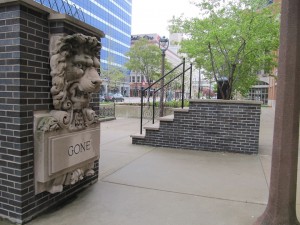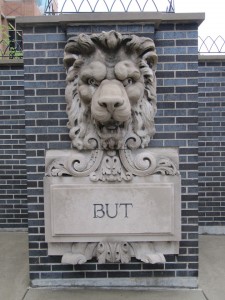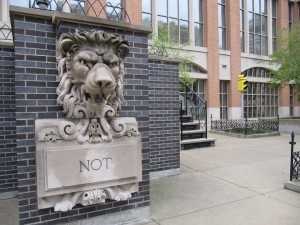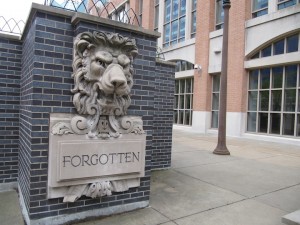City Yard: A memorial verb without an object
07 May 2012 – Adina Langer
These intriguing images, previewed in last week’s “In Search of a Label” post, depict a public artwork by Sheila Klein called “City Yard,” commissioned as part of the development of the Frontier Airlines Center in Milwaukee in the 1990s. Information about the artwork and its history has proved elusive for an observer based outside of Milwaukee. I’ve had to rely on a Wikipedia “stub” for a basic description of the piece noting the media as: “landscape elements, limestone architectural ornament, and salvaged public works objects such as fire hydrants and the classic blue police call box.” The stub references a 1998 article by James Auer in the Milwaukee Journal Sentinel called “INGRAINED Art – Creative works spice up personality of new convention center.” Unfortunately, the Journal Sentinel’s online archive, a sadly aborted project powered by Google, is devoid of a scan for the article’s date.



 So, without the time to interview the artist, what’s left to an observer is the artwork itself. At first glance, “City Yard” might seem to be a generic public space beside a generic convention center, all wrought-iron rails and brick planters. But upon closer examination, the architectural elements and “public works objects” stand reverently, like monuments in a graveyard. The words beneath the lions’ mouths on the four-sided central structure of the piece further evoke a memorial sentiment: “Gone But Not Forgotten.” Like the stairway leading up to a tree that marks the border of the space closest to the convention center building, the whole piece seems to be a question mark incarnate. Who or what is gone? How are we to avoid forgetting if we don’t know what we are commemorating? Are we mourning for a time when the civic structure of the city provided a sense of comfort and community? There are still police officers and and firefighters without these particular call boxes and hydrants. But these objects inhabit a protected past behind their wrought-iron fences.
So, without the time to interview the artist, what’s left to an observer is the artwork itself. At first glance, “City Yard” might seem to be a generic public space beside a generic convention center, all wrought-iron rails and brick planters. But upon closer examination, the architectural elements and “public works objects” stand reverently, like monuments in a graveyard. The words beneath the lions’ mouths on the four-sided central structure of the piece further evoke a memorial sentiment: “Gone But Not Forgotten.” Like the stairway leading up to a tree that marks the border of the space closest to the convention center building, the whole piece seems to be a question mark incarnate. Who or what is gone? How are we to avoid forgetting if we don’t know what we are commemorating? Are we mourning for a time when the civic structure of the city provided a sense of comfort and community? There are still police officers and and firefighters without these particular call boxes and hydrants. But these objects inhabit a protected past behind their wrought-iron fences.
In a museum, the same objects might be used to tell a story, to narrate the development of cherished institutions within a meta-narrative of progress. At the nearby Milwaukee Public Museum, the slightly miniaturized buildings and scenes of the “Streets of Old Milwaukee” exhibit seem to do just that, flavored with a heavy infusion of nostalgia. “City Yard” is not exactly nostalgic, nor is it entirely mournful, and it is certainly not informative. It is an ephemeral timescape, a verb without an object, entreating the busy visitors to a modern convention center to remember for remembering’s sake.
~ Adina Langer




Having stayed at a hotel about a mile from the conference, I walked to and from the convention center each day and was also intrigued by this piece, especially that it can’t be viewed as a “whole” from any angle–it’s always separate pieces and words that are only brought together as a phrase if someone takes the time to examine it. It was chilly during the conference, but it didn’t seem that the sculpture saw many visitors, whether interested in it or not, as the area where it was, seemed like somewhat marginalized space on the side of the convention center. So, maybe on some level, it is both gone, but not forgotten?